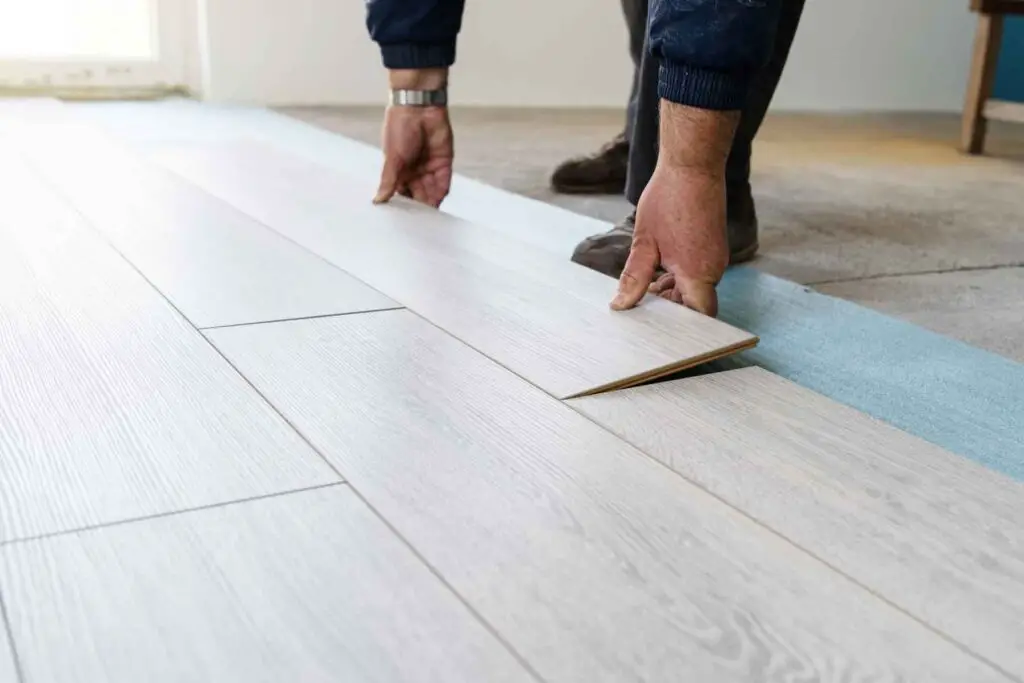Laminate basement flooring over concrete has become an increasingly popular choice for homeowners who seek a perfect blend of aesthetic quality, durability, and cost-effectiveness.
This type of flooring offers a beautiful, low-maintenance surface that can withstand the moisture-rich environment often found in basements. Versatile and available in various designs, laminate flooring provides a practical solution for transforming your basement into a stylish and comfortable space.
Proper flooring in basements is of paramount importance due to the unique conditions these spaces often present. Basements are typically susceptible to higher levels of moisture and humidity, which can lead to problems like mold, mildew, and even structural damage.
Choosing a suitable flooring, such as laminate over concrete, can significantly mitigate these issues. It helps in maintaining a healthy, safe environment while also enhancing the overall aesthetic appeal of the space.
Furthermore, the correct flooring can add to the basement’s practicality, turning it into a functional area for relaxation or activities, hence increasing the home’s overall value.
Pros and Cons of Laminate Basement Flooring
Advantages of Laminate Flooring in Basements
- Moisture Resistance: Laminate flooring is designed to resist moisture, a common issue in basements. This feature can help prevent the growth of mold and mildew.
- Durability: Laminate flooring is incredibly durable and can withstand heavy traffic, making it an excellent choice for active-family homes.
- Easy Installation: The installation process of laminate flooring is straightforward and can be done quickly, saving homeowners time and effort.
- Cost-Effective: Compared to other flooring options like hardwood or tile, laminate flooring is quite affordable while still offering an appealing aesthetic.
- Variety of Styles: Laminate flooring comes in a wide array of styles, colors, and patterns, allowing homeowners to customize their basement’s look.
- Easy Maintenance: Cleaning and maintaining laminate flooring is simple, requiring only standard sweeping or vacuuming and occasional mopping.
- Comfortable Underfoot: Unlike concrete, laminate flooring provides a warmer and softer surface, creating a more comfortable space.
Disadvantages of Laminate Flooring in Basements
- Susceptibility to Water Damage: While laminate flooring is resistant to moisture, it is not completely waterproof. In cases of severe flooding or persistent leaks, the laminate material can warp or become damaged.
- Hardness: Although more comfortable than concrete, laminate flooring can still be relatively hard underfoot compared to carpet or cork. This might be an issue in play areas or workout spaces.
- Sound Transmission: Laminate flooring can be noisy to walk on, potentially creating echoes in your basement. Acoustic underlayment can help, but it’s an additional cost.
- Cannot be Refinished: Unlike hardwood, laminate flooring can’t be refinished. If it gets scratched or worn, the entire floor or damaged section will need to be replaced.
- Potential for Slipperiness: Laminate flooring can be slippery when wet, posing a potential hazard in areas prone to moisture or spills.
- Aesthetic Limitations: While laminate can mimic the look of various materials, it might not fully achieve the depth and texture of natural materials, which could be a drawback for some homeowners.
- Environmental Concerns: Some types of laminate flooring may contain chemicals that can release volatile organic compounds (VOCs) into the air, affecting indoor air quality. It’s crucial to choose a laminate product certified for low VOC emissions.
Overview of Concrete Basement Floors

Characteristics of Concrete Basement Floors
Concrete basement floors inherently possess a raw, industrial aesthetic, lending themselves to a range of contemporary decor styles. This stark aesthetic can be softened with the use of rugs or by choosing to stain or paint the concrete for a more polished look.
Durability: Concrete floors are incredibly durable and resistant to damage. Unlike laminate, they can handle significant wear and tear, making them a long-lasting option for basements.
Water Resistance: Concrete floors excel in basements prone to dampness or flooding. They are highly resistant to water damage, and with appropriate sealing, they won’t warp or rot.
Ease of Maintenance: Concrete floors are relatively easy to maintain. Regular sweeping and occasional wet mopping with a neutral cleaning solution will keep your floor looking its best.
Cost-effective: Concrete floors are generally more affordable than many flooring options, including laminate, making them an economical choice for large basement areas.
Thermal Mass: Concrete has excellent thermal mass properties, meaning it can absorb, store, and slowly release heat or coolness. This can contribute to an energy-efficient basement.
Customizable: Despite its initially cold and impersonal appearance, concrete is highly customizable. It can be stained, painted, stamped, or polished to create a variety of looks to suit any decor style.
Challenges with Concrete Basement Floors
Despite the numerous benefits of concrete basement floors, they do come with a set of challenges that homeowners must consider.
Hard and Unforgiving: This inherent attribute of concrete can make it uncomfortable to stand on for long periods. Falling or dropping items on it may result in damage or breakage.
Cold and Damp: Concrete floors can feel cold and damp underfoot, particularly in basements, where temperatures are typically lower.
Prone to Cracks: Concrete, while durable, is not entirely resistant to cracks. Changes in temperature and humidity may cause the concrete to expand and contract, leading to cracks over time.
Aesthetically Limited: The industrial appeal of concrete may not resonate with everyone. Its gray, raw look can feel too stark or cold for some homeowners, who may miss the warmth and homey feeling provided by other materials like laminate or hardwood.
Noisy: Concrete does not absorb sound in the same way that softer, more fibrous materials do. This quality can lead to increased noise levels, particularly in high-traffic areas.
Requires Sealing: Concrete floors require regular sealing to maintain their durability and water resistance. This can be a time-consuming and costly process, particularly in larger basements where the square footage is substantial.
Installation and Levelling: Installing a concrete floor can be a complex process, requiring professional expertise to ensure the floor is correctly leveled and finished. This can add to the overall cost and time taken to install a concrete basement floor.
The Process of Installing Laminate Flooring Over Concrete

Preparation of the Concrete Floor
Before you can install laminate basement flooring over concrete, the concrete floor itself must be properly prepared. This step is critical as any inconsistency or imperfection in the concrete floor can affect the installation and longevity of the laminate flooring.
Materials and Tools Required
- Concrete sealer: A concrete sealer is necessary to prevent moisture from seeping up through the concrete and damaging the laminate.
- Laminate flooring: Ensure you have enough to cover your entire basement floor area, plus extra in case of errors or future repairs.
- Underlayment: This layer goes between the concrete and the laminate to provide cushioning, noise reduction, and moisture protection.
- Tape Measure: For accurate measurements.
- Pry bar and Hammer: To remove existing baseboards if necessary.
- Utility knife: To cut the underlayment.
- Flooring installation kit: This typically includes spacers, a tapping block, and a pull bar.
Step-by-step Installation Process
Clean the Concrete: The first step in installing laminate basement flooring over concrete is to thoroughly clean the concrete surface. Remove any debris, dust, or existing adhesives and ensure the floor is dry.
Seal the Concrete: Apply the concrete sealer according to the manufacturer’s directions and allow it to dry fully. This will prevent moisture from damaging the laminate.
Install the Underlayment: Roll out the underlayment across the concrete floor. Cut it to size using your utility knife and ensure it covers the entire floor surface.
Install the Laminate: Begin at the most visible wall and work your way across the room. Using the spacers from your flooring installation kit, leave an expansion gap between the laminate and the wall.
Connect the boards according to the manufacturer’s instructions, usually by snapping them together. Use a tapping block and hammer to secure them if needed.
Cutting to Fit: When you reach the end of a row, you may need to cut a plank to fit. Measure the remaining space and subtract the expansion gap to get the correct size.
Finishing: Once all laminate planks are installed, remove the spacers and install baseboards and trim to cover the expansion gaps. Trim should not be directly attached to the laminate flooring as it needs space to expand and contract.
Related Topics:
Maintenance of Laminate Flooring in Basements
Routine Cleaning and Care Tips
Laminate flooring in basements requires regular maintenance to keep it looking its best. Begin with routine sweeping or vacuuming to remove everyday dirt and debris. You can also use a dry dust mop if preferred.
For a deeper clean, use a damp mop with a laminate-safe cleaner. To avoid water damage, make sure the mop is not overly wet. For stubborn stains or spills, a mild solution of vinegar and water can be used sparingly.
It’s important to remember to never use harsh chemicals or abrasive cleaning tools as they can strip the laminate’s finish.
Precautions to Prevent Damage
There are several precautions you can take to prevent damage to your laminate basement flooring. Avoid allowing puddles of water to sit on the floor for prolonged periods – always clean up spills immediately.
Also, consider using furniture pads beneath heavy items to prevent scratches and dents. If moving furniture, lift it rather than dragging it across the floor. Additionally, keep the room’s temperature and humidity levels consistent to prevent warping or buckling of the laminate.
Investing in a dehumidifier can be a good idea to help control moisture in the basement. Prevention is the best way to ensure the longevity of your laminate flooring.
Conclusion
To wrap up, laminate basement flooring over concrete is an excellent option for those seeking a cost-effective, aesthetically pleasing, and durable solution for their basement floor. Easy to install and maintain, this type of flooring can significantly enhance the look and functionality of your basement space.
While it does come with a few potential drawbacks like susceptibility to significant water damage, with proper care and precautions, these issues can be effectively managed.
It’s also important to remember that the success of laminate flooring in a basement heavily relies on the initial preparation of the concrete floor and regular maintenance afterward.
As always, when making a major home improvement decision, it’s advised to weigh the pros and cons and consider your specific needs and circumstances.
With its diverse design options and practical advantages, laminate flooring can truly transform your basement from a simple storage area to a valuable extension of your living space.
FAQs
Can I install laminate basement flooring over concrete myself?
Yes, installing laminate flooring over a concrete basement is a straightforward process that many homeowners choose to do themselves. It involves preparing the concrete, laying down an underlayment, and then installing the laminate planks. However, if you’re not comfortable with DIY projects or if the basement has complex issues like severe moisture or uneven surfaces, it’s recommended to hire a professional.
How do I prepare a concrete basement floor for laminate installation?
Preparation is crucial for a successful laminate flooring installation over a concrete basement floor. Start by cleaning the concrete floor thoroughly, and removing any debris or dust. If there are any cracks or holes, these should be filled in and smoothed out. Then, a moisture barrier should be installed to prevent any moisture from the concrete from reaching the laminate. You can then install an underlayment, which will provide some cushioning and noise reduction, before installing the laminate planks.
